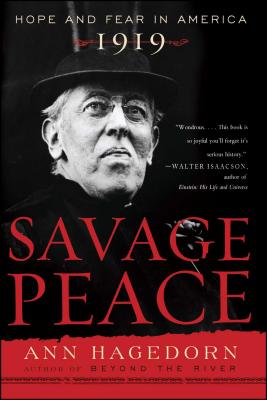Savage Peace: Hope and Fear in America, 1919

Savage Peace: Hope and Fear in America, 1919
Written with the sweep of an epic novel and grounded in extensive research into contemporary documents, Savage Peace is a striking portrait of American democracy under stress. It is the surprising story of America in the year 1919. In the aftermath of an unprecedented worldwide war and a flu pandemic, Americans began the year full of hope, expecting to reap the benefits of peace. But instead, the fear of terrorism filled their days. Bolshevism was the new menace, and the federal government, utilizing a vast network of domestic spies, began to watch anyone deemed suspicious. A young lawyer named J. Edgar Hoover headed a brand-new intelligence division of the Bureau of Investigation (later to become the FBI). Bombs exploded on the doorstep of the attorney general's home in Washington, D.C., and thirty-six parcels containing bombs were discovered at post offices across the country. Poet and journalist Carl Sandburg, recently returned from abroad with a trunk full of Bolshevik literature, was detained in New York, his trunk seized. A twenty-one-year-old Russian girl living in New York was sentenced to fifteen years in prison for protesting U.S. intervention in Arctic Russia, where thousands of American soldiers remained after the Armistice, ostensibly to guard supplies but in reality to join a British force meant to be a warning to the new Bolshevik government. In 1919, wartime legislation intended to curb criticism of the government was extended and even strengthened. Labor strife was a daily occurrence. And decorated African-American soldiers, returning home to claim the democracy for which they had risked their lives, were badly disappointed. Lynchings continued, race riots would erupt in twenty-six cities before the year ended, and secret agents from the government's "Negro Subversion" unit routinely shadowed outspoken African-Americans. Adding a vivid human drama to the greater historical narrative, Savage Peace brings 1919 alive through the people who played a major role in making the year so remarkable. Among them are William Monroe Trotter, who tried to put democracy for African-Americans on the agenda at the Paris peace talks; Supreme Court associate justice Oliver Wendell Holmes Jr., who struggled to find a balance between free speech and legitimate gov
PRP: 218.17 Lei
Acesta este Prețul Recomandat de Producător. Prețul de vânzare al produsului este afișat mai jos.
196.35Lei
196.35Lei
218.17 LeiLivrare in 2-4 saptamani
Descrierea produsului
Written with the sweep of an epic novel and grounded in extensive research into contemporary documents, Savage Peace is a striking portrait of American democracy under stress. It is the surprising story of America in the year 1919. In the aftermath of an unprecedented worldwide war and a flu pandemic, Americans began the year full of hope, expecting to reap the benefits of peace. But instead, the fear of terrorism filled their days. Bolshevism was the new menace, and the federal government, utilizing a vast network of domestic spies, began to watch anyone deemed suspicious. A young lawyer named J. Edgar Hoover headed a brand-new intelligence division of the Bureau of Investigation (later to become the FBI). Bombs exploded on the doorstep of the attorney general's home in Washington, D.C., and thirty-six parcels containing bombs were discovered at post offices across the country. Poet and journalist Carl Sandburg, recently returned from abroad with a trunk full of Bolshevik literature, was detained in New York, his trunk seized. A twenty-one-year-old Russian girl living in New York was sentenced to fifteen years in prison for protesting U.S. intervention in Arctic Russia, where thousands of American soldiers remained after the Armistice, ostensibly to guard supplies but in reality to join a British force meant to be a warning to the new Bolshevik government. In 1919, wartime legislation intended to curb criticism of the government was extended and even strengthened. Labor strife was a daily occurrence. And decorated African-American soldiers, returning home to claim the democracy for which they had risked their lives, were badly disappointed. Lynchings continued, race riots would erupt in twenty-six cities before the year ended, and secret agents from the government's "Negro Subversion" unit routinely shadowed outspoken African-Americans. Adding a vivid human drama to the greater historical narrative, Savage Peace brings 1919 alive through the people who played a major role in making the year so remarkable. Among them are William Monroe Trotter, who tried to put democracy for African-Americans on the agenda at the Paris peace talks; Supreme Court associate justice Oliver Wendell Holmes Jr., who struggled to find a balance between free speech and legitimate gov
Detaliile produsului










